key Seat Mii 2013 Owner's manual
[x] Cancel search | Manufacturer: SEAT, Model Year: 2013, Model line: Mii, Model: Seat Mii 2013Pages: 306, PDF Size: 4.3 MB
Page 5 of 306
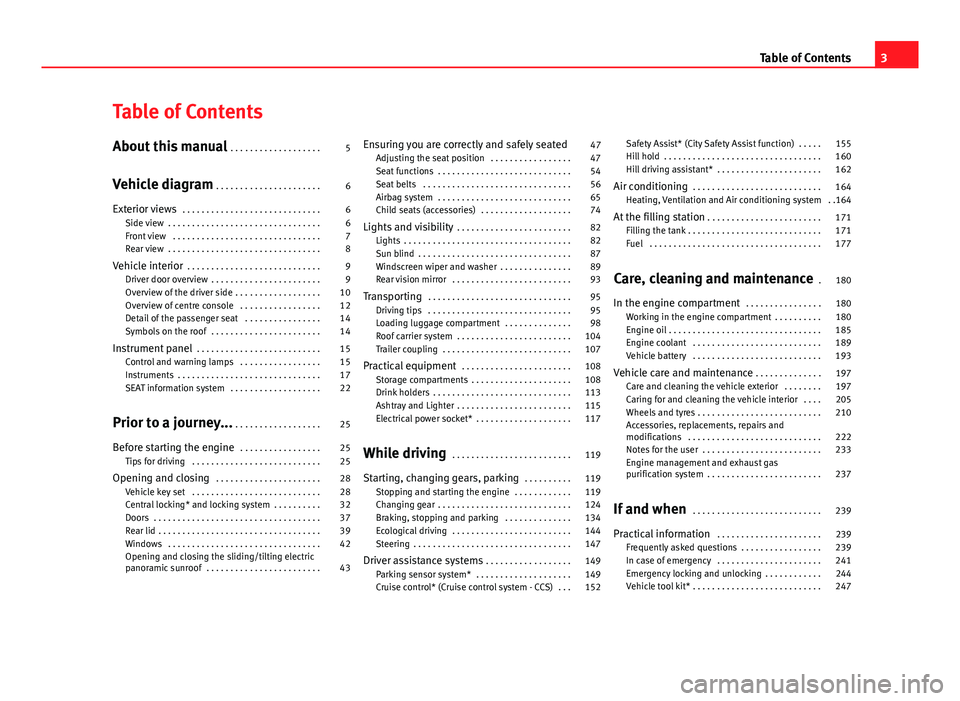
Table of Contents
About this manual . . . . . . . . . . . . . . . . . . . 5
Vehicle diagram . . . . . . . . . . . . . . . . . . . . . . 6
Exterior views . . . . . . . . . . . . . . . . . . . . . . . . . . . . . 6
Side view . . . . . . . . . . . . . . . . . . . . . . . . . . . . . . . . 6
Front view . . . . . . . . . . . . . . . . . . . . . . . . . . . . . . . 7
Rear view . . . . . . . . . . . . . . . . . . . . . . . . . . . . . . . . 8
Vehicle interior . . . . . . . . . . . . . . . . . . . . . . . . . . . . 9
Driver door overview . . . . . . . . . . . . . . . . . . . . . . . 9
Overview of the driver side . . . . . . . . . . . . . . . . . . 10
Overview of centre console . . . . . . . . . . . . . . . . . 12
Detail of the passenger seat . . . . . . . . . . . . . . . . 14
Symbols on the roof . . . . . . . . . . . . . . . . . . . . . . . 14
Instrument panel . . . . . . . . . . . . . . . . . . . . . . . . . . 15
Control and warning lamps . . . . . . . . . . . . . . . . . 15
Instruments . . . . . . . . . . . . . . . . . . . . . . . . . . . . . . 17
SEAT information system . . . . . . . . . . . . . . . . . . . 22
Prior to a journey... . . . . . . . . . . . . . . . . . . 25
Before starting the engine . . . . . . . . . . . . . . . . . 25
Tips for driving . . . . . . . . . . . . . . . . . . . . . . . . . . . 25
Opening and closing . . . . . . . . . . . . . . . . . . . . . . 28
Vehicle key set . . . . . . . . . . . . . . . . . . . . . . . . . . . 28
Central locking* and locking system . . . . . . . . . . 32
Doors . . . . . . . . . . . . . . . . . . . . . . . . . . . . . . . . . . . 37
Rear lid . . . . . . . . . . . . . . . . . . . . . . . . . . . . . . . . . . 39
Windows . . . . . . . . . . . . . . . . . . . . . . . . . . . . . . . . 42
Opening and closing the sliding/tilting electric
panoramic sunroof . . . . . . . . . . . . . . . . . . . . . . . . 43 Ensuring you are correctly and safely seated
47
Adjusting the seat position . . . . . . . . . . . . . . . . . 47
Seat functions . . . . . . . . . . . . . . . . . . . . . . . . . . . . 54
Seat belts . . . . . . . . . . . . . . . . . . . . . . . . . . . . . . . 56
Airbag system . . . . . . . . . . . . . . . . . . . . . . . . . . . . 65
Child seats (accessories) . . . . . . . . . . . . . . . . . . . 74
Lights and visibility . . . . . . . . . . . . . . . . . . . . . . . . 82
Lights . . . . . . . . . . . . . . . . . . . . . . . . . . . . . . . . . . . 82
Sun blind . . . . . . . . . . . . . . . . . . . . . . . . . . . . . . . . 87
Windscreen wiper and washer . . . . . . . . . . . . . . . 89
Rear vision mirror . . . . . . . . . . . . . . . . . . . . . . . . . 93
Transporting . . . . . . . . . . . . . . . . . . . . . . . . . . . . . . 95
Driving tips . . . . . . . . . . . . . . . . . . . . . . . . . . . . . . 95
Loading luggage compartment . . . . . . . . . . . . . . 98
Roof carrier system . . . . . . . . . . . . . . . . . . . . . . . . 104
Trailer coupling . . . . . . . . . . . . . . . . . . . . . . . . . . . 107
Practical equipment . . . . . . . . . . . . . . . . . . . . . . . 108
Storage compartments . . . . . . . . . . . . . . . . . . . . . 108
Drink holders . . . . . . . . . . . . . . . . . . . . . . . . . . . . . 113
Ashtray and Lighter . . . . . . . . . . . . . . . . . . . . . . . . 115
Electrical power socket* . . . . . . . . . . . . . . . . . . . . 117
While driving . . . . . . . . . . . . . . . . . . . . . . . . . 119
Starting, changing gears, parking . . . . . . . . . . 119
Stopping and starting the engine . . . . . . . . . . . . 119
Changing gear . . . . . . . . . . . . . . . . . . . . . . . . . . . . 124
Braking, stopping and parking . . . . . . . . . . . . . . 134
Ecological driving . . . . . . . . . . . . . . . . . . . . . . . . . 144
Steering . . . . . . . . . . . . . . . . . . . . . . . . . . . . . . . . . 147
Driver assistance systems . . . . . . . . . . . . . . . . . . 149
Parking sensor system* . . . . . . . . . . . . . . . . . . . . 149
Cruise control* (Cruise control system - CCS) . . . 152 Safety Assist* (City Safety Assist function) . . . . . 155
Hill hold . . . . . . . . . . . . . . . . . . . . . . . . . . . . . . . . . 160
Hill driving assistant* . . . . . . . . . . . . . . . . . . . . . . 162
Air conditioning . . . . . . . . . . . . . . . . . . . . . . . . . . . 164
Heating, Ventilation and Air conditioning system . .164
At the filling station . . . . . . . . . . . . . . . . . . . . . . . . 171
Filling the tank . . . . . . . . . . . . . . . . . . . . . . . . . . . . 171
Fuel . . . . . . . . . . . . . . . . . . . . . . . . . . . . . . . . . . . . 177
Care, cleaning and maintenance . 180
In the engine compartment . . . . . . . . . . . . . . . . 180
Working in the engine compartment . . . . . . . . . . 180
Engine oil . . . . . . . . . . . . . . . . . . . . . . . . . . . . . . . . 185
Engine coolant . . . . . . . . . . . . . . . . . . . . . . . . . . . 189
Vehicle battery . . . . . . . . . . . . . . . . . . . . . . . . . . . 193
Vehicle care and maintenance . . . . . . . . . . . . . . 197
Care and cleaning the vehicle exterior . . . . . . . . 197
Caring for and cleaning the vehicle interior . . . . 205
Wheels and tyres . . . . . . . . . . . . . . . . . . . . . . . . . . 210
Accessories, replacements, repairs and
modifications . . . . . . . . . . . . . . . . . . . . . . . . . . . . 222
Notes for the user . . . . . . . . . . . . . . . . . . . . . . . . . 233
Engine management and exhaust gas
purification system . . . . . . . . . . . . . . . . . . . . . . . . 237
If and when . . . . . . . . . . . . . . . . . . . . . . . . . . . 239
Practical information . . . . . . . . . . . . . . . . . . . . . . 239
Frequently asked questions . . . . . . . . . . . . . . . . . 239
In case of emergency . . . . . . . . . . . . . . . . . . . . . . 241
Emergency locking and unlocking . . . . . . . . . . . . 244
Vehicle tool kit* . . . . . . . . . . . . . . . . . . . . . . . . . . . 247
3
Table of Contents
Page 16 of 306

14Vehicle interior
Detail of the passenger seat
Fig. 8 Overview of the
passenger side
Legend for the Fig. 8:
Position of passenger front airbag on the dash panel . . . . . . .65
Air outlets . . . . . . . . . . . . . . . . . . . . . . . . . . . . . . . . . . . . . . . . . . . . . . . . 164
In the side of the dash panel: Key switch for switching off the
front passenger airbag 1)
. . . . . . . . . . . . . . . . . . . . . . . . . . . . . . . . . . . 65
Handle of the storage compartment or storage compartment
open 1)
. . . . . . . . . . . . . . . . . . . . . . . . . . . . . . . . . . . . . . . . . . . . . . . . . . . . 108
1
23
4
Symbols on the roof
SymbolMeaning
Interior lights
⇒ page 82.
1)
According to version
Page 30 of 306
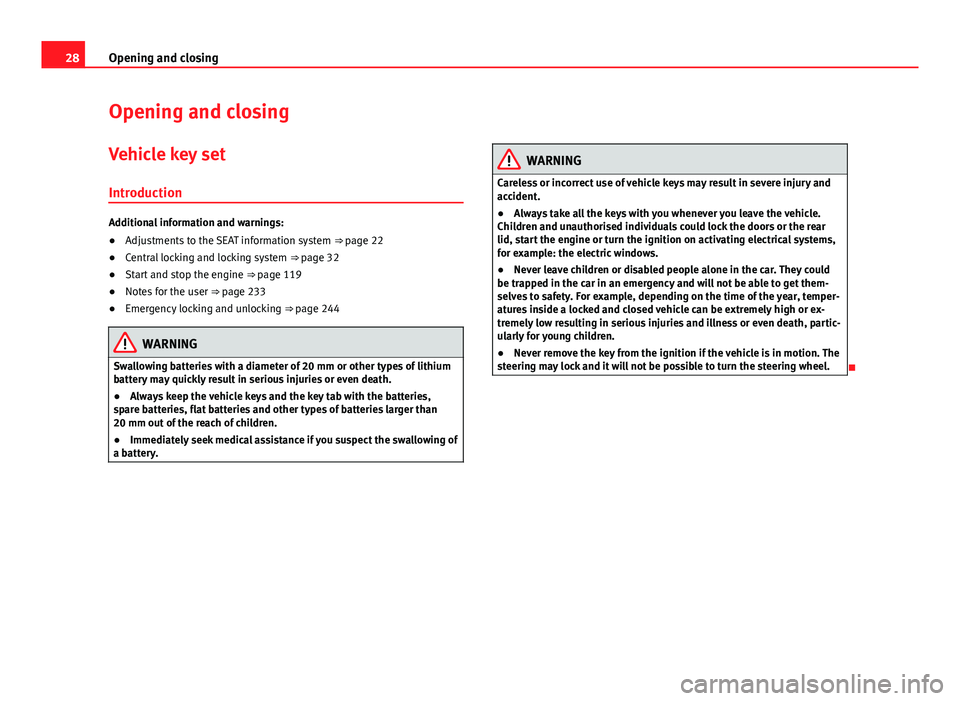
28Opening and closing
Opening and closing
Vehicle key set
Introduction
Additional information and warnings:
● Adjustments to the SEAT information system ⇒ page 22
● Central locking and locking system ⇒ page 32
● Start and stop the engine ⇒ page 119
● Notes for the user ⇒ page 233
● Emergency locking and unlocking ⇒ page 244
WARNING
Swallowing batteries with a diameter of 20 mm or other types of lithium
battery may quickly result in serious injuries or even death.
● Always keep the vehicle keys and the key tab with the batteries,
spare batteries, flat batteries and other types of batteries larger than
20 mm out of the reach of children.
● Immediately seek medical assistance if you suspect the swallowing of
a battery.
WARNING
Careless or incorrect use of vehicle keys may result in severe injury and
accident.
● Always take all the keys with you whenever you leave the vehicle.
Children and unauthorised individuals could lock the doors or the rear
lid, start the engine or turn the ignition on activating electrical systems,
for example: the electric windows.
● Never leave children or disabled people alone in the car. They could
be trapped in the car in an emergency and will not be able to get them-
selves to safety. For example, depending on the time of the year, temper-
atures inside a locked and closed vehicle can be extremely high or ex-
tremely low resulting in serious injuries and illness or even death, partic-
ularly for young children.
● Never remove the key from the ignition if the vehicle is in motion. The
steering may lock and it will not be possible to turn the steering wheel.
Page 31 of 306
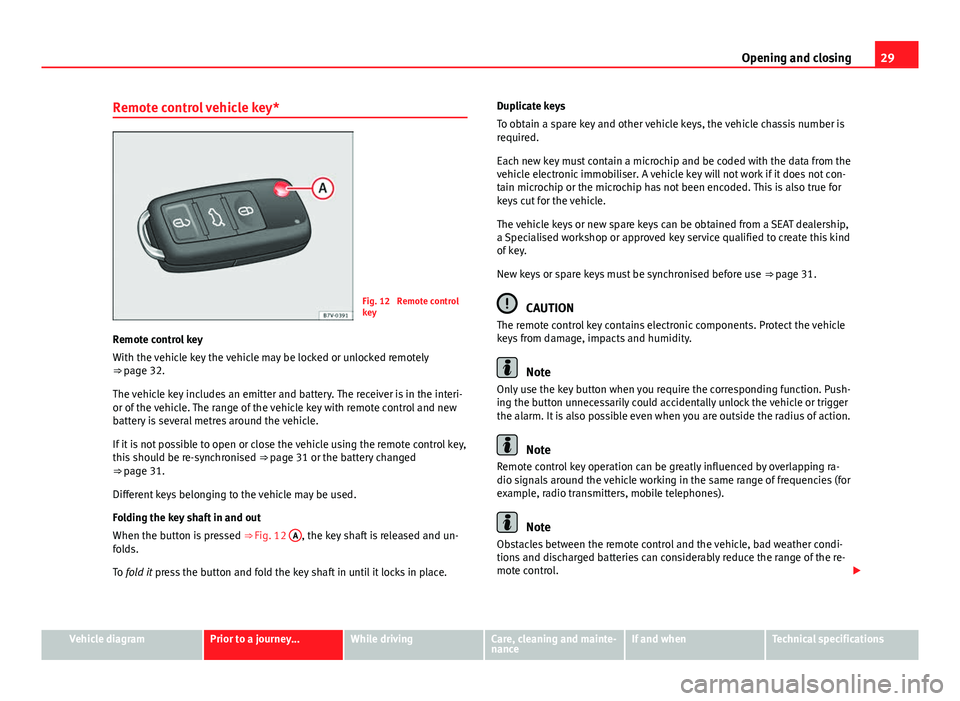
29
Opening and closing
Remote control vehicle key*
Fig. 12 Remote control
key
Remote control key
With the vehicle key the vehicle may be locked or unlocked remotely
⇒ page 32.
The vehicle key includes an emitter and battery. The receiver is in the interi-
or of the vehicle. The range of the vehicle key with remote control and new
battery is several metres around the vehicle.
If it is not possible to open or close the vehicle using the remote control key,
this should be re-synchronised ⇒ page 31 or the battery changed
⇒ page 31.
Different keys belonging to the vehicle may be used.
Folding the key shaft in and out
When the button is pressed ⇒ Fig. 12 A
, the key shaft is released and un-
folds.
To fold it press the button and fold the key shaft in until it locks in place. Duplicate keys
To obtain a spare key and other vehicle keys, the vehicle chassis number is
required.
Each new key must contain a microchip and be coded with the data from the
vehicle electronic immobiliser. A vehicle key will not work if it does not con-
tain microchip or the microchip has not been encoded. This is also true for
keys cut for the vehicle.
The vehicle keys or new spare keys can be obtained from a SEAT dealership,
a Specialised workshop or approved key service qualified to create this kind
of key.
New keys or spare keys must be synchronised before use
⇒ page 31.
CAUTION
The remote control key contains electronic components. Protect the vehicle
keys from damage, impacts and humidity.
Note
Only use the key button when you require the corresponding function. Push-
ing the button unnecessarily could accidentally unlock the vehicle or trigger
the alarm. It is also possible even when you are outside the radius of action.
Note
Remote control key operation can be greatly influenced by overlapping ra-
dio signals around the vehicle working in the same range of frequencies (for
example, radio transmitters, mobile telephones).
Note
Obstacles between the remote control and the vehicle, bad weather condi-
tions and discharged batteries can considerably reduce the range of the re-
mote control.
Vehicle diagramPrior to a journey...While drivingCare, cleaning and mainte-
nanceIf and whenTechnical specifications
Page 32 of 306
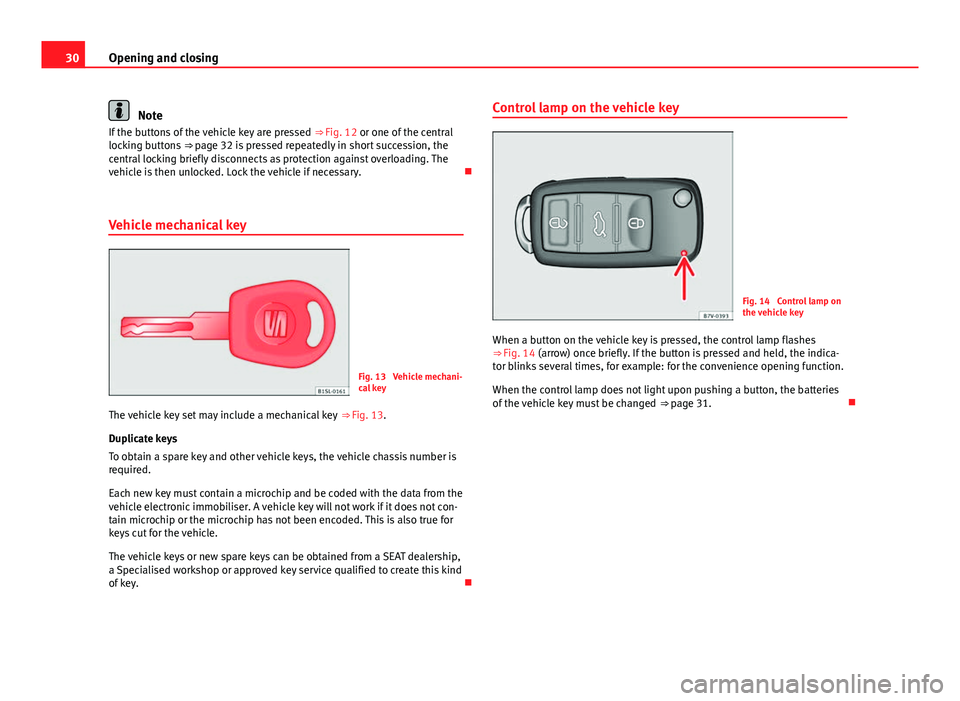
30Opening and closing
Note
If the buttons of the vehicle key are pressed ⇒ Fig. 12 or one of the central
locking buttons ⇒ page 32 is pressed repeatedly in short succession, the
central locking briefly disconnects as protection against overloading. The
vehicle is then unlocked. Lock the vehicle if necessary.
Vehicle mechanical key
Fig. 13 Vehicle mechani-
cal key
The vehicle key set may include a mechanical key ⇒ Fig. 13.
Duplicate keys
To obtain a spare key and other vehicle keys, the vehicle chassis number is
required.
Each new key must contain a microchip and be coded with the data from the
vehicle electronic immobiliser. A vehicle key will not work if it does not con-
tain microchip or the microchip has not been encoded. This is also true for
keys cut for the vehicle.
The vehicle keys or new spare keys can be obtained from a SEAT dealership,
a Specialised workshop or approved key service qualified to create this kind
of key. Control lamp on the vehicle key
Fig. 14 Control lamp on
the vehicle key
When a button on the vehicle key is pressed, the control lamp flashes
⇒ Fig. 14 (arrow) once briefly. If the button is pressed and held, the indica-
tor blinks several times, for example: for the convenience opening function.
When the control lamp does not light upon pushing a button, the batteries
of the vehicle key must be changed ⇒ page 31.
Page 33 of 306
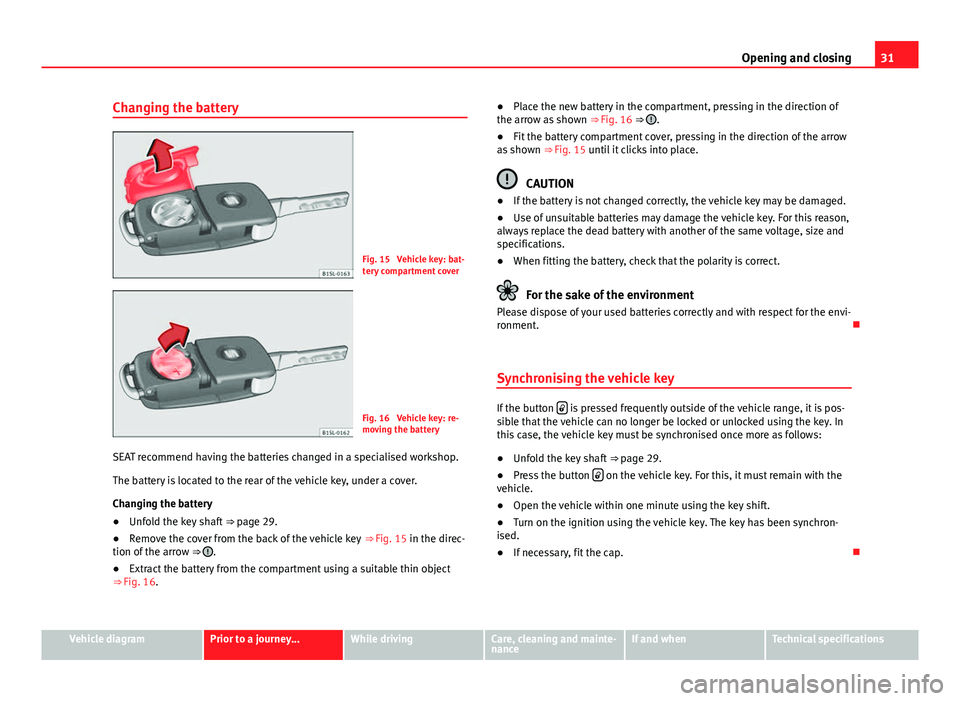
31
Opening and closing
Changing the battery
Fig. 15 Vehicle key: bat-
tery compartment cover
Fig. 16 Vehicle key: re-
moving the battery
SEAT recommend having the batteries changed in a specialised workshop.
The battery is located to the rear of the vehicle key, under a cover.
Changing the battery
● Unfold the key shaft
⇒ page 29.
● Remove the cover from the back of the vehicle key
⇒ Fig. 15 in the direc-
tion of the arrow ⇒
.
● Extract the battery from the compartment using a suitable thin object
⇒ Fig. 16. ●
Place the new battery in the compartment, pressing in the direction of
the arrow as shown ⇒ Fig. 16 ⇒
.
● Fit the battery compartment cover, pressing in the direction of the arrow
as shown ⇒ Fig. 15 until it clicks into place.
CAUTION
● If the battery is not changed correctly, the vehicle key may be damaged.
● Use of unsuitable batteries may damage the vehicle key. For this reason,
always replace the dead battery with another of the same voltage, size and
specifications.
● When fitting the battery, check that the polarity is correct.
For the sake of the environment
Please dispose of your used batteries correctly and with respect for the envi-
ronment.
Synchronising the vehicle key
If the button is pressed frequently outside of the vehicle range, it is pos-
sible that the vehicle can no longer be locked or unlocked using the key. In
this case, the vehicle key must be synchronised once more as follows:
● Unfold the key shaft
⇒ page 29.
● Press the button
on the vehicle key. For this, it must remain with the
vehicle.
● Open the vehicle within one minute using the key shift.
● Turn on the ignition using the vehicle key. The key has been synchron-
ised.
● If necessary, fit the cap.
Vehicle diagramPrior to a journey...While drivingCare, cleaning and mainte-
nanceIf and whenTechnical specifications
Page 34 of 306
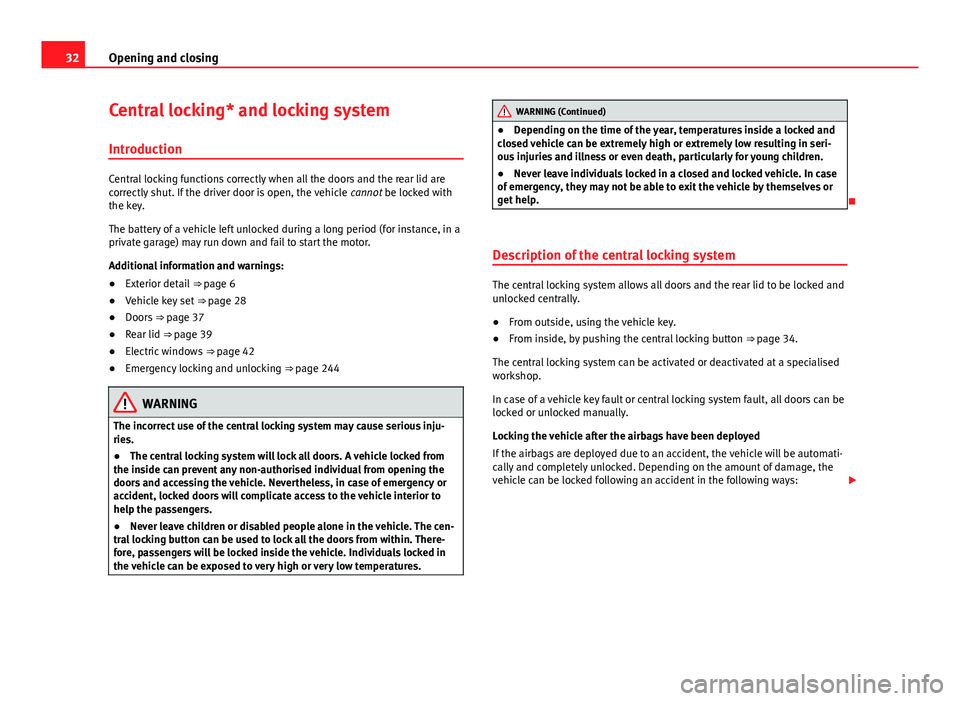
32Opening and closing
Central locking* and locking system
Introduction
Central locking functions correctly when all the doors and the rear lid are
correctly shut. If the driver door is open, the vehicle cannot be locked with
the key.
The battery of a vehicle left unlocked during a long period (for instance, in a
private garage) may run down and fail to start the motor.
Additional information and warnings:
● Exterior detail ⇒ page 6
● Vehicle key set ⇒ page 28
● Doors ⇒ page 37
● Rear lid ⇒ page 39
● Electric windows ⇒ page 42
● Emergency locking and unlocking ⇒ page 244
WARNING
The incorrect use of the central locking system may cause serious inju-
ries.
● The central locking system will lock all doors. A vehicle locked from
the inside can prevent any non-authorised individual from opening the
doors and accessing the vehicle. Nevertheless, in case of emergency or
accident, locked doors will complicate access to the vehicle interior to
help the passengers.
● Never leave children or disabled people alone in the vehicle. The cen-
tral locking button can be used to lock all the doors from within. There-
fore, passengers will be locked inside the vehicle. Individuals locked in
the vehicle can be exposed to very high or very low temperatures.
WARNING (Continued)
● Depending on the time of the year, temperatures inside a locked and
closed vehicle can be extremely high or extremely low resulting in seri-
ous injuries and illness or even death, particularly for young children.
● Never leave individuals locked in a closed and locked vehicle. In case
of emergency, they may not be able to exit the vehicle by themselves or
get help.
Description of the central locking system
The central locking system allows all doors and the rear lid to be locked and
unlocked centrally.
● From outside, using the vehicle key.
● From inside, by pushing the central locking button ⇒ page 34.
The central locking system can be activated or deactivated at a specialised
workshop.
In case of a vehicle key fault or central locking system fault, all doors can be
locked or unlocked manually.
Locking the vehicle after the airbags have been deployed
If the airbags are deployed due to an accident, the vehicle will be automati-
cally and completely unlocked. Depending on the amount of damage, the
vehicle can be locked following an accident in the following ways:
Page 35 of 306
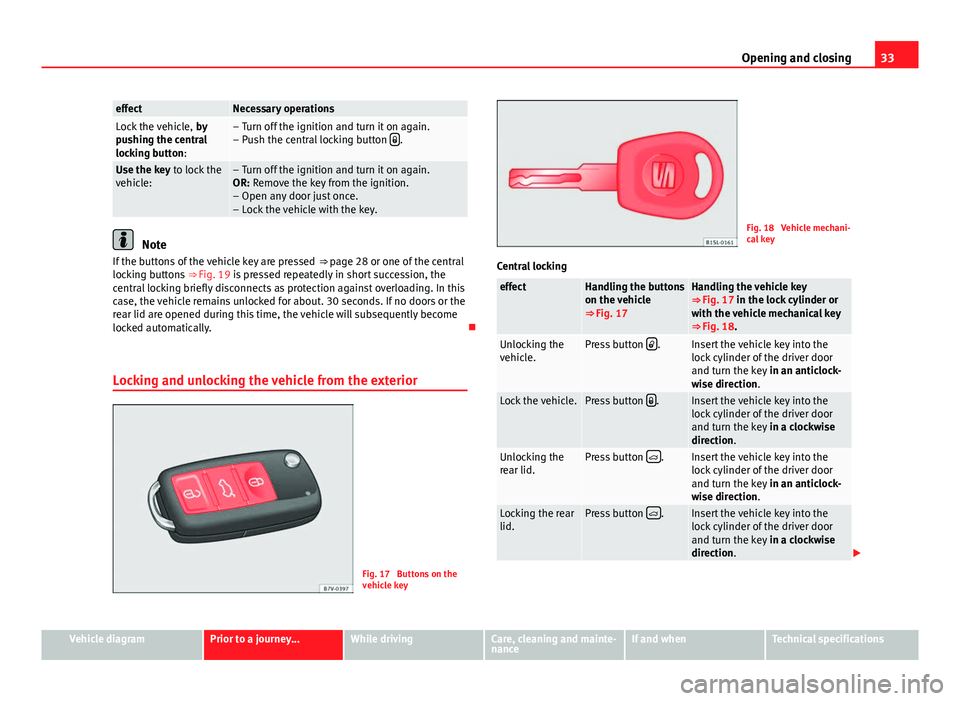
33
Opening and closing
effectNecessary operationsLock the vehicle, by
pushing the central
locking button:– Turn off the ignition and turn it on again.
– Push the central locking button .
Use the key to lock the
vehicle:– Turn off the ignition and turn it on again.
OR: Remove the key from the ignition.
– Open any door just once.
– Lock the vehicle with the key.
Note
If the buttons of the vehicle key are pressed ⇒ page 28 or one of the central
locking buttons ⇒ Fig. 19 is pressed repeatedly in short succession, the
central locking briefly disconnects as protection against overloading. In this
case, the vehicle remains unlocked for about. 30 seconds. If no doors or the
rear lid are opened during this time, the vehicle will subsequently become
locked automatically.
Locking and unlocking the vehicle from the exterior
Fig. 17 Buttons on the
vehicle key
Fig. 18 Vehicle mechani-
cal key
Central locking
effectHandling the buttons
on the vehicle
⇒ Fig. 17Handling the vehicle key
⇒ Fig. 17 in the lock cylinder or
with the vehicle mechanical key
⇒ Fig. 18.
Unlocking the
vehicle.Press button .Insert the vehicle key into the
lock cylinder of the driver door
and turn the key
in an anticlock-
wise direction.
Lock the vehicle.Press button .Insert the vehicle key into the
lock cylinder of the driver door
and turn the key
in a clockwise
direction.
Unlocking the
rear lid.Press button .Insert the vehicle key into the
lock cylinder of the driver door
and turn the key
in an anticlock-
wise direction.
Locking the rear
lid.Press button .Insert the vehicle key into the
lock cylinder of the driver door
and turn the key
in a clockwise
direction.
Vehicle diagramPrior to a journey...While drivingCare, cleaning and mainte-
nanceIf and whenTechnical specifications
Page 36 of 306

34Opening and closing
Please note: Depending on the operating of the central locking set by the
Specialised workshop, in order to unlock all the doors and the rear lid,
press the button
twice.
The vehicle key only locks and unlocks the vehicle if it is within range of the
vehicle and if the battery has enough power.
● Upon locking the vehicle, all turn signals will flash once in confirmation.
● Upon unlocking the vehicle, all turn signals will flash twice in confirma-
tion.
If the turn signals do not flash in confirmation, at least one of the doors or
the rear lid has been left unlocked.
If the driver door is open, the vehicle cannot be locked with the key. If you
unlock the vehicle without opening any doors or the rear lid, it will lock
again automatically after a few seconds. This function prevents the vehicle
from remaining unlocked if the unlocking button is pressed by mistake.
Mechanical locking
effectHandling the vehicle mechanical key ⇒ Fig. 18
in the lock cylinder.
Locking the driver door
manually.
To unlock, insert the vehicle key into the lock cyl-
inder of the driver door and turn the key in an
anticlockwise direction.
To lock, insert the vehicle key into the lock cylin-
der of the driver door and turn the key in a clock-
wise direction.
Locking and unlocking
the rear lid.
To unlock, insert the vehicle key into the lock cyl-
inder of the driver door and turn the key in an
anticlockwise direction.
To lock, insert the vehicle key into the lock cylin-
der of the driver door and turn the key in a clock-
wise direction.
If the driver door is open, the vehicle cannot be locked with the vehicle key. Locking and unlocking the vehicle from the inside
Fig. 19 In the driver
door: central locking but-
ton
Fig. 20 In the passenger
door: Door handle for me-
chanical locking
Page 37 of 306
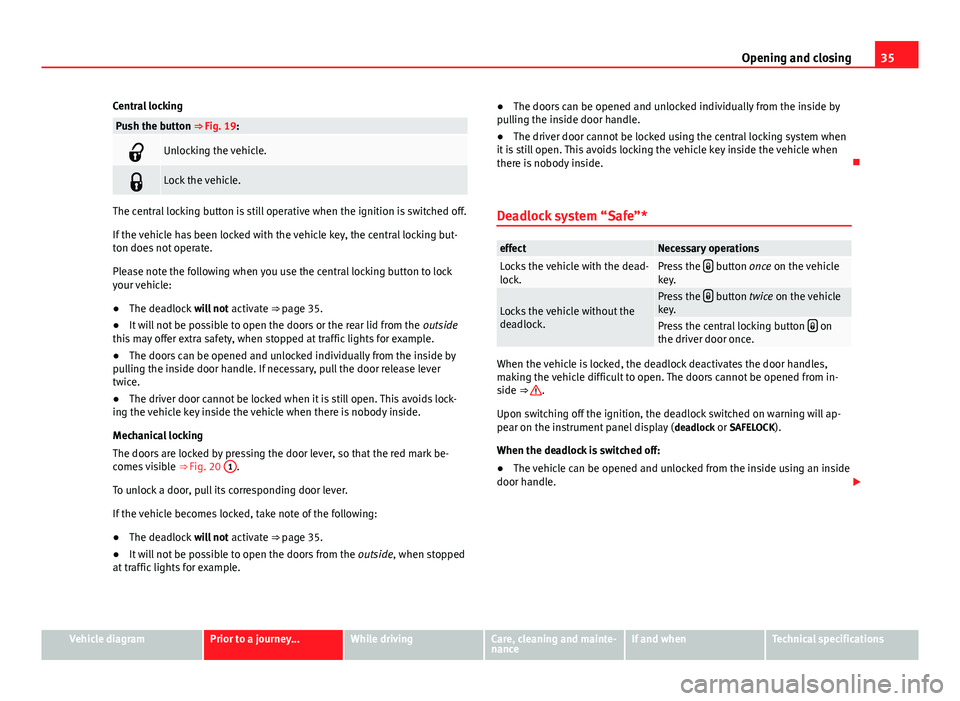
35
Opening and closing
Central locking
Push the button ⇒ Fig. 19:
Unlocking the vehicle.
Lock the vehicle.
The central locking button is still operative when the ignition is switched off.
If the vehicle has been locked with the vehicle key, the central locking but-
ton does not operate.
Please note the following when you use the central locking button to lock
your vehicle:
● The deadlock will not activate ⇒ page 35.
● It will not be possible to open the doors or the rear lid from the outside
this may offer extra safety, when stopped at traffic lights for example.
● The doors can be opened and unlocked individually from the inside by
pulling the inside door handle. If necessary, pull the door release lever
twice.
● The driver door cannot be locked when it is still open. This avoids lock-
ing the vehicle key inside the vehicle when there is nobody inside.
Mechanical locking
The doors are locked by pressing the door lever, so that the red mark be-
comes visible ⇒ Fig. 20 1
.
To unlock a door, pull its corresponding door lever.
If the vehicle becomes locked, take note of the following:
● The deadlock will not activate ⇒ page 35.
● It will not be possible to open the doors from the outside, when stopped
at traffic lights for example. ●
The doors can be opened and unlocked individually from the inside by
pulling the inside door handle.
● The driver door cannot be locked using the central locking system when
it is still open. This avoids locking the vehicle key inside the vehicle when
there is nobody inside.
Deadlock system “Safe”*
effectNecessary operationsLocks the vehicle with the dead-
lock.Press the button once on the vehicle
key.
Locks the vehicle without the
deadlock.Press the button twice on the vehicle
key.
Press the central locking button on
the driver door once.
When the vehicle is locked, the deadlock deactivates the door handles,
making the vehicle difficult to open. The doors cannot be opened from in-
side ⇒
.
Upon switching off the ignition, the deadlock switched on warning will ap-
pear on the instrument panel display ( deadlock or SAFELOCK).
When the deadlock is switched off:
● The vehicle can be opened and unlocked from the inside using an inside
door handle.
Vehicle diagramPrior to a journey...While drivingCare, cleaning and mainte-
nanceIf and whenTechnical specifications